Training Bob
(or: Bob has a mid-life crisis)
Ok. Nothing new. He has them pretty often these days...
My intent is to improve my performance and enjoyment of cross country
skiing. I only work out 2 to 4 times a week - a total of 3 to 6 hours.
I'm trying to maximize my results by focusing on improving my endurance
and increasing my AT (Anaerobic Threshold). The following page details
my personal approach to training. I highly recommend developing your own
workout program tailored to your own interests.
Intended first running race of my life:
Silicon Valley Marathon (the whole 26 miles) on October 28, 2001. (I'll
be 44. yippee!) My primary goal is finishing. A faster-than-median time
would be icing. I believe that if I can just keep moving for 5 hours, then
I can finish the race.
Immensely helpful running coach:
Danny at ChiRunning.com runs
clinics and classes all over the SF Bay Area and world. Mary and I spent
90 minutes (we had to go to another engagement) the day before running
the B2B at a large group clinic (about 30 people associated with the MITcrc).
Danny showed us both the problems in our techniques that were causing us
injury. He showed us how to correct the mistakes and how to move beyond
them to a style of running that's actually fun and easy. |
I ran my first race for 70 minutes at my
AT. Although I had to ice one knee for the rest of the day, I ran faster
and with less injury than I've ever run before. (of course, this was my
first race... but I usually have to ice both knees after
putting out this level of activity). More on Danny as I take more courses
from him... (that's Danny in the yellow shorts) |
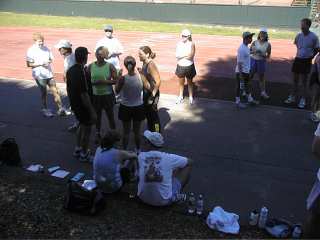 |
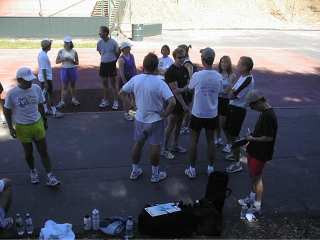 |
Training Methodology
The following is my distillation of various endurance sports training
philosophies. The best source that I've found so far is "SERIOUS
training for endurance athletes" by Rob Sleamaker and Ray Browning.
The SERIOUS in the title is an acronym for the 7 types of training involved
for effective competition. John gave me this link to another good source
is www.exrx.net.
(Another one used to be asimba.com,but
they're in the process of selling out to a fitness magazine group that
I can't recommend).
Heart Rate training
The HR (heart rate) graphs that follow were recorded using my new Polar
410 HRM (heart rate monitor). As is true for most HRMs, the Polar uses
a chest strap to detect and transmit the electrical heart beat signals
to a wrist watch. The wrist watch receives the chest strap signals and
displays the current HR. After pre-setting target HR zones and intended
workout profiles, the HRM becomes a personal trainer. The personal trainer
from HELL!!! <g>
Bob's Vital statistics:
DOB Oct. 1957 (43)
weight 135 lbs (62 kg)
height 5' 6" (1.7 meters)
resting HR 45 bpm
max HR 192 bpm
AT HR 167 bpm
Some people have an innate sense of the intensity of their activity.
They know how long they can maintain a particular level of work without
even thinking about it. For the rest of us, there are HRMs...
Training "zones" are a shorthand for exercise intensity levels. They
are typically derived from the resting and max HR using a standard formula
(50%, 60%, etc.). Max HR is often calculated using another average formula
based on an average of gender and age data. For example (in lbs and years):
Male max HR = 214 - age/2 - weight/20 (for me, that would
be 185)
Female max HR = 210 - age/2 - weight/20
The difference between 192 (my actual, measured max HR) and 185 (the
supposed population average) is half of a zone (see table, below). This
is a substantial difference and shows why you need to know what your personal
physiology is capable of before you "buy into" a generic program. I continue
to refine my own zones:
| zone |
standard |
my HR |
purpose |
| non zone (doesn't count in aerobic training) |
0 to 50% from resting to max |
45 to 127 bpm |
weight training often falls here. Since weight training uses only one
or 2 muscle groups in slow, controlled motions, the cardio system is not
really being taxed. |
| zone 1 |
50 to 60% |
127 to 135 |
"distance". Builds aerobic base. 1/2 total training hours should be
in this zone. |
| zone 2 |
60 to 70% |
136 to 148 |
"endurance". Substantial training in this zone as race season nears.
This is my "base race pace". Used to conserve energy during racing. |
| zone 3 |
70 to 80% |
149 to 161 |
avoid this zone in training. May be used in racing but cost may be
high relative to performance. |
| zone 4 |
80 to 90% |
162 to 176 |
"interval peaks". Sustainable for racing as needed. After racing at
167 for 90 minutes on XC skis, I've decided that this is my best estimate
of my AT (Anaerobic Threshold, see Interval, below). |
| zone 5 |
90 to 95% |
177 to 184 |
Sprint zone. Hill climbing zone during XC races. Not sustainable for
long periods. In my case, not often achievable, let alone sustainable. |
| 5++ |
>95% |
185 to 192 |
is not really considered training. It's reserved for all-out sprint
portions of races, testing, and trying to give yourself a heart attack
<g>. |
The HR charts below are divided into color bands that are supposed to
indicate my training zones. I haven't had time to figure out why they don't
match the zones that I actually use. I'm sure that there is some way to
set the zones in the software, but I haven't gotten around to doing it...OK.
So, given that I've only been doing this HR training thing for less than
a year (and not terribly seriously, at that), here are some recent training
plots:
Interval
This is the most painful of my workouts. I only do this 2 to 3 times a
month. I can't really work out for a couple of days after one of these.
Don't try this at home, kids!
What you're looking at:
I started with a 15 minute warm-up jogging around the pool at a very
slow pace (11 to 12 minute miles). Then, I work the intervals. The idea
is to push my AT (Anaerobic Threshold) up by pushing myself just beyond
my current AT, holding at that output for as long as I can, and then giving
myself a recovery period. As you can see, I can't stay at the top end for
very long.
If I were an elite athlete, I would stay at zone 4 for 90 to 120 seconds
before falling back for a recovery period. Thank god I have a good day
job...
After the intervals, I spent 20 minutes in the weight room. The strength
exercises were designed to build core strength (not big arms!). I did a
single set of 12 to 20 reps of each: delts, traps, lower back, and quads.
Although many people do more than one set, the most gain is gotten from
the first set. It's important to overload the muscles to the point of failure,
but without breaking good form. In particular, you don't want to throw
the weight because momentum doesn't build muscle. Count 4 on the way up
and 6 on the way down for maximum effect.
I finished with a 10 minute stretch period that loosened every muscle
group worked that day. |
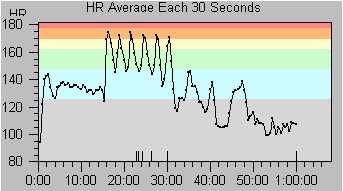 |
Endurance
This would be race practice for my marathon. Had I really been at zone
2, my HR would have been about 7 to 10 beats higher than what you see here.
Maybe next time...Anyway: I'm running 12 minute miles and I can sustain
it for as long as I need to (knees willing) to finish the race. It won't
set any records, but it will keep me from the dreaded DNF (did not finish)
result.
This was actually a compound workout: the first 40 minutes was spent
running from my house to the gym via various side streets. The second 40
minutes was a strength training class (Peggy Flynn's "Muscle Pump" at the
Capital Club in San Jose). Note the 5 minute stretch between them and the
10 minute stretch at the end. Stretching is VERY important.
Two to three weeks before the race, I intend to put in one run of 150
to 180 minutes at "endurance" pace. Then, I begin the "ramp down" to conserve
energy before running FURTHER THAN I'VE EVER RUN
BEFORE.
Wish me luck... |
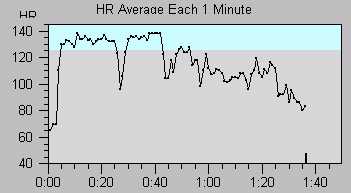 |
Distance
Most of my workout time is now spent like this. It's not really hard. In
fact, it's kind of boring. But, (in theory) it's building my aerobic base
for the other training. We'll see... It's helpful to run somewhere interesting
(urban or wild) to ease the boredom.
This was a 110 minute run along the Coyote creek levee from Brokaw road
to beyond highway 237 and back (9 miles). Note the 10 minute stretch at
the end.
|
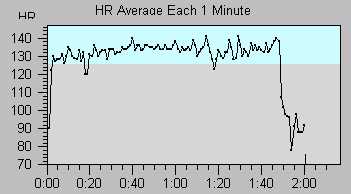 |
High Impact Aerobics
Compare the graphs above with a typical high-impact aerobics class like
Boot Camp (Sheriane at Capital Club Athletics in San Jose). Although the
graph has peaks that hit 168, there are only a couple that get that high
so it isn't as effective at raising my AT as a deliberate interval workout.
Most of the peaks merely put me into the dreaded "zone 3".
I enjoy these classes. I see my fellow gym buddies and instructors.
I work areas that I might not remember to work alone (abs, back...everyone
has weaker parts that they don't like to work), but the same peer pressure
that keeps me going also discourages me from exercising at exactly the
intensity level that will work best for me.
Also note the zero recorded near the end. I still don't know why, but
the Polar can't detect my HR while I'm in the car. Life still has mysteries. |
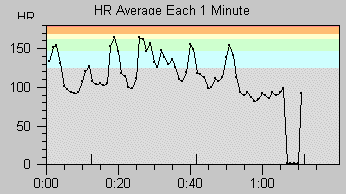 |
Nutrition
Hydration
During the distance run (above), I drank an entire liter (of plain ice
water) from my Camelback (several pulls every mile) hydration fanny pack
and ate a power bar (lemon crisp is the least inedible - I think it's the
rice that keeps it from feeling exactly like glue). I sucked
down another liter while stretching and another liter about 30 minutes
later. Water good. Dehydration bad. I don't worry much about electrolyte
loss. I don't run in the heat of the day, and I weigh less than 1/2 the
weight of the typical Florida State football player. Gatorade makes me
nauseous. I don't know why. Until I find something better, I'll stick with
water.
Carbs
The powerbar is necessary for most of my workouts. Without it, I run out
of energy at about the 40 minute to 1 hour mark (depending on intensity).
With it, I can get through anything. For those of you thinking that all
that sugar is bad for me: the PB has about 200 kcal. The workouts burn
500 to 900 kcal. Do the math. The PB has almost no fat, a little protein
and a lot of carbs (calories) that digest at a pretty good rate for me.
Don't make your body consume muscle mass to keep you going. Feed it sugar,
instead.
Diet
Bottom line: Eat what you want, but check the label. Most "energy bars"
are loaded with fat (30 to 50% of their calories). That's why they taste
so good. When you do eat fatty things, make sure they are the best damn
fatty things you can get (butter, foire gras, moscarpone, etc.) and just
don't eat very much of them. Fat is good when you need high calorie-to-mass
(think Idinerod) but terrible for training. Protein is another overrated
component of "sports food". Americans get plenty of protein in their regular
diet. You don't need to add more unless you're a "bodybuilder". If that's
the case, then you need to see a competent mental health professional AND
a nutritionist.





